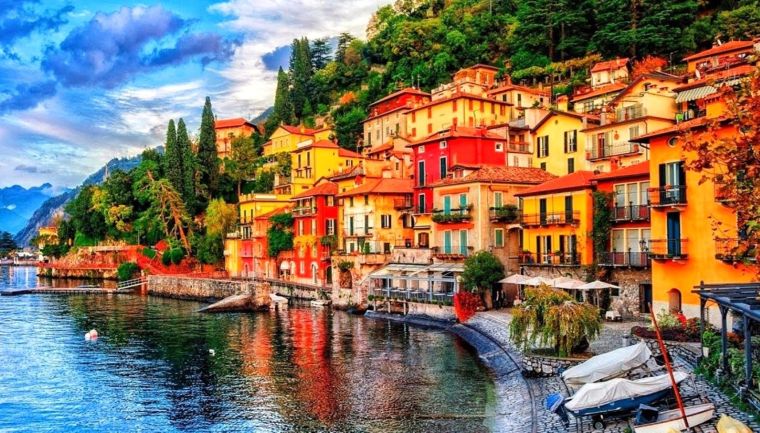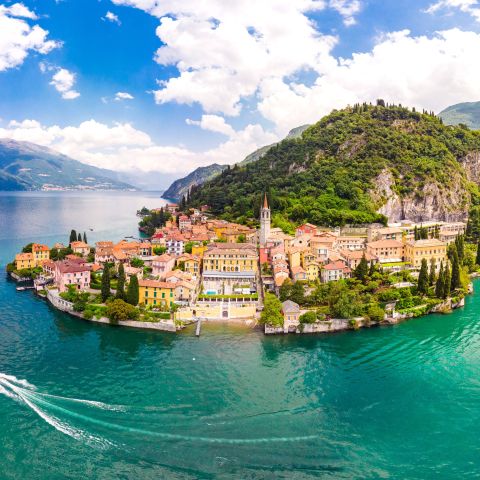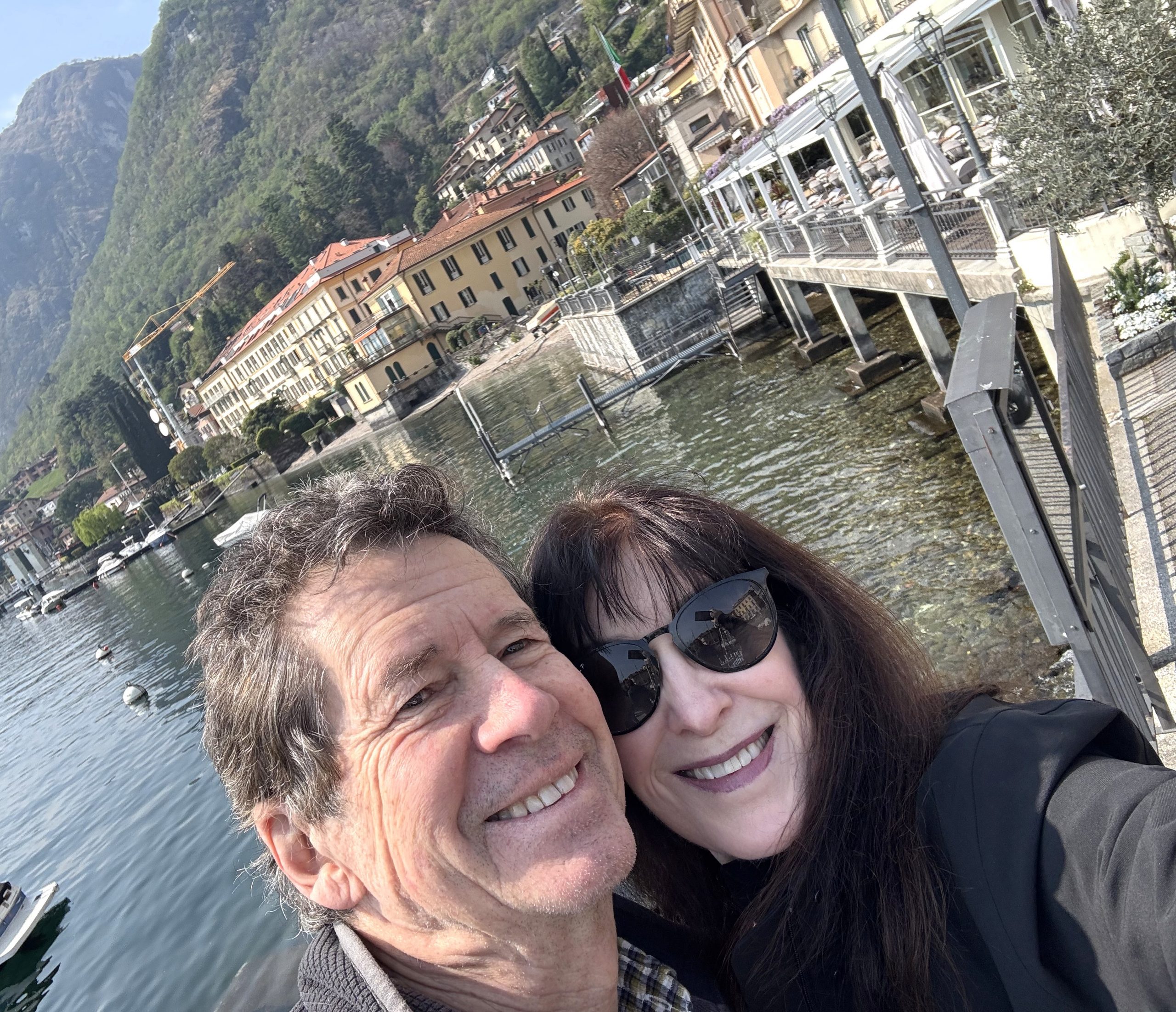
The first time I heard the word “Como” was when my mother introduced me to a very popular song in 1960 called Delaware by the then ultra-successful American singer Perry Como. My mother played the 45-rpm record for me over and over because my nine-year-old brain thought the lyrics were very clever. The singer queried, “What did Dela-ware, boy?” and answered himself with the line, “She wore a brand New Jersey.” Perry had a smooth-as-silk voice and wooed the women of his day with his kind of watered down, pop pseudo-Italian musical whimsy. I didn’t know at the time that his last name was the name of a famous Italian lake that would one day capture my attention.
By the time I was in high school, I was fascinated by geography – everything from local topographic maps to monster library atlases heavy enough to crush your toes. I pored over every inch of the world and memorized names of faraway exotic-sounding names of cities, rivers, mountains and lakes. And sure enough, there was that curious-looking long finger of a glacially formed body of water in the northern border of Italy named Lake Como.
When I first spied images of this mountain-rimmed lake, I hoped that someday I would go there and see what it had to offer. Down through the decades, I did travel to various parts of Italy and found joyous moments in places like Cinque Terre, Montepulciano and Lucca, but grew jaded with the touristy limoncello sweetness of the towns along the Amalfi Coast and the insanely crowded piazzas of Naples, Rome and Venice. I had almost given up on Italy when Linda suggested we had not yet explored Lombardy in northern Italy, and she assured me it would be much nicer, more rugged and adventurous than the dingy streets of Napoli.
A hasty internet search enhanced my knowledge of currently famous people who lived along Lake Como or at least had multi-million-euro pied-a-terre dwellings on its shores. This list included George Clooney, Madonna, Richard Branson, Sylvester Stallone and Brad Pitt, among them. Other stars and even the Obamas apparently made sustained visits there as well.
This made me wonder, however – did I really want to visit the haunts of the rich and famous? No, not really. But I was also reminded that Lake Como was the setting – both real and idealized – of my favourite Robin Williams film, What Dreams May Come. That film knocked me out and immortalized Lake Como as a kind of paradisiacal afterlife destination in a way that made me want to see it for myself.
When I took a quick dip into the history of the region, I was floored yet again to discover that once upon a time, long ago, ancient peoples had this idyllic valley mostly all to themselves. And oddly enough, those people were Celts. They were known as the Orobii and they lived (happily, one might reckon) along the shores and in the hills around Lake Como and other locations in northern Italy during the Iron Age.

Now, to be honest, it’s not like I sit around thinking, where is the next Celtic destination that Linda and I should travel to? It’s just that so many times I come up with a nagging notion to go somewhere, and it turns out that, long ago, the Celts were there first. Ireland, Scotland, Cornwall, Wales, for sure. But also, northern Portugal, Bretagne, Croatia, Switzerland, etc., etc. And now Lombardy and its famous lake of the stars.
So, we flew to Milan where we were pleasantly shocked to discover you could rent a car in Italy without a lot of fussing and arguing. And that was a good omen. Of course, driving to Como took us through various industrial wastelands that reminded me of my birth state of New Jersey. But, as we began to drive the snaky road along the perimeter of the lake, the magic began to present itself.
You should know that Lago di Como, also known as Lario, is the third-largest lake in Italy, in case you are ever asked this question on a quiz show. It’s 46 kilometers long, has a unique shape like the letter Y, and was carved out by glaciers 10,000 years ago. Our destination was the town of Perledo perched high above the shore town of Varenna.
Perledo was once a popular retreat for aristocratic Romans, replete with incredible panoramic views of the lake and nicely maintained Old-World charm. And it had a moderately priced short-term rental home waiting for us at the end of our long slog to get there. A steep, narrow switchback road took us up from the lake to our destination, which had a magnificent view across the water to Menaggio on the other side. Our side of the lake was said to be a bit quieter than the towns of Como, Menaggio or Bellagio, and we were happy about that. Nearby, there were hiking trails through lush forests that were once trade routes and pilgrim tracks dating back to the time of the Orobii, and we were anxious to trek along them and explore what we could.
Our base for travel was Varenna. We could hike down there on a handy but precipitously steep local footpath and catch ferries to various destinations, thus avoiding driving for most of the time we were there. On our first trip down to Varenna, we promenaded along the shoreline on “Lovers Walk” – a delightful promenade with wisteria hanging down from the rock walls – and tiny wavelets lapping at the shoreline. It was a bit crowded, which is no surprise, and we had to dodge endless couples taking selfies at arm’s length. ExploreLakeComo.com notes that “The walk of lovers is a short pedestrian path cantilevered over water in Varenna. It affords romantic views of Lake Como, the mountains, and the small village…The red fenced promenade in Varenna, with its steep alleys and quaint corners, attracts lovers from all around the world.” And I guess that included Linda and me, but I wondered if in fact somewhere out there in the world were couples who, upon discovering they were deeply in love, felt an immediate urge to travel to Varenna just to walk arm in arm along the shore here.
Our first ferry ride took us to Menaggio, where we hiked as many back streets and alleys as we could find, soaking in the old city. Any trace of the Celts was long gone and even the remnants of the wall that once surrounded the town were hard to locate. But once you removed yourself from the hustle of the main arteries, it was delightful to travel back in time mentally, a small reminder that in some of the most tourist-laden towns of Europe, a few steps beyond the binge of souvenir shops and street vendors can take you to places that are at least reasonably authentic.
Back in Varenna, I quickly learned that hiking back up to Perledo involved a lot of huffing and puffing for a flat-land coastal lad like me, but Linda veritably sprinted on up the mountain to our abode while I lagged behind, occasionally relying on the help of a dependable ancient stone wall to keep me upright to catch my breath.
 We quickly learned to get out early in the morning to avoid the influx of visitors coming into the train station at the bottom of our path, where throngs of people would disembark from Milan trains and race to the ferries. We were here in April, so the crowds were tolerable, but I soon learned that even the local tourist office had issued a decree saying, “Don’t come here in the summer,” another indication of just how overcrowded some well-known travel destinations have become.
We quickly learned to get out early in the morning to avoid the influx of visitors coming into the train station at the bottom of our path, where throngs of people would disembark from Milan trains and race to the ferries. We were here in April, so the crowds were tolerable, but I soon learned that even the local tourist office had issued a decree saying, “Don’t come here in the summer,” another indication of just how overcrowded some well-known travel destinations have become.
Our second voyage across the water took us south to Bellagio, another shore town of about 4,000 souls, considered by many to be the most beautiful of the lake towns. Salita Serbelloni is “the most photographed street” in Bellagio and one writer described going there “like stepping into an Italian dream.” I would learn later that there is a hotel/casino in Las Vegas named The Bellagio with a fancy fountain that does funny things and itself is considered “the most photographed fountain in the world.” Leave it to the Americans to try to upstage even the Trevi Fountain in Rome. Bellagio is known as “The Pearl of Lake Como” and it is indeed picturesque, boasting as a host town to any number of Hollywood celebrities.
Linda and I, mere mortals, were nonetheless happy to wander around the city and waltz through the greenery of the parks but balked at paying large euros to visit some of the fancier gardens in the old estates. Turismo Como reports that, “We know from Titus Livius that in 520 B.C. groups of Celts (coming from Gaul under the command of Bellovesus) invaded the region of the lake. In fact, a legend suggests the name of Bellagio derives from the name of this barbaric chieftain.” Reading this, I had to reimagine my vision of these particular Celtic folks that I had always thought were rather civilized, peace-loving tribes until the dastardly Romans came along and bullied them out of their happy homes.
The truth of the matter, however, is that each time I dip into historical tidbits about the ancient Celts anywhere, I find conflicting information and end up realizing that true Celtic history for me will remain forever mysterious, elusive and somewhat confounding.
Cruising back and forth across the fine lake was always a grand way to travel, and the fresh Lake Como air and jaw-dropping scenery never disappointed. Back in our digs at Perledo, I discovered a small black scorpion in our dining room. When I captured him in a cup, I ran with him outside to deposit him in the bushes but ended up dropping him down into our neighbour’s patio. Fortunately, the apartment there seemed to be closed for the season, and I soon learned that even if someone were bitten by one of these small Italian cousins to the larger, meaner ones, the result would be no worse than a serious bee sting.
We ping-ponged across that historic lake a number of times, mostly able to avoid the train crowds of urbanites who seemed to swarm the Como towns on a daily basis. Considering the crowds, we almost missed going to Bellano, which was just up the shore from us. But upon discovering the town had a gorgeous downtown gorge, Linda convinced me we better get down into that grand gully before we tottered off to more distant regions.
Bellano likes to call itself the “town of artists” due to the concentration of painters and poets cloistered there, and it has been noted that the architecture has Celtic influences. I didn’t detect any overt hints of either of those, but we were blown away by Orrido di Bellano, which is a wondrous narrow canyon, deep and dramatic, that snakes its way right into the heart of the city. Parking was an issue, and I don’t have praise for the impatient drivers clogging the city streets, but must admit they were considerably less erratic, dangerous and nasty than the maniacs who harassed us on the narrow byways of the Napoli Coast farther south.
 Once we got to our destination, however, everyone was cordial and polite as we wended our way along the gorge’s boardwalk with the cascading water drowning out any sounds from the nearby city streets. According to Discovering Bellano, the gorge was “created 15 million years ago by the erosion of the River Pioverna and the Adda glacier which, over the centuries, have shaped the rock into gigantic potholes, dark ravines and suggestive caves.” We have our share of gigantic potholes in Nova Scotia and even a couple of dark ravines for sure, but these were my first “suggestive” caves, and I couldn’t help but wonder what that suggested.
Once we got to our destination, however, everyone was cordial and polite as we wended our way along the gorge’s boardwalk with the cascading water drowning out any sounds from the nearby city streets. According to Discovering Bellano, the gorge was “created 15 million years ago by the erosion of the River Pioverna and the Adda glacier which, over the centuries, have shaped the rock into gigantic potholes, dark ravines and suggestive caves.” We have our share of gigantic potholes in Nova Scotia and even a couple of dark ravines for sure, but these were my first “suggestive” caves, and I couldn’t help but wonder what that suggested.
To be continued…















Leave a Comment